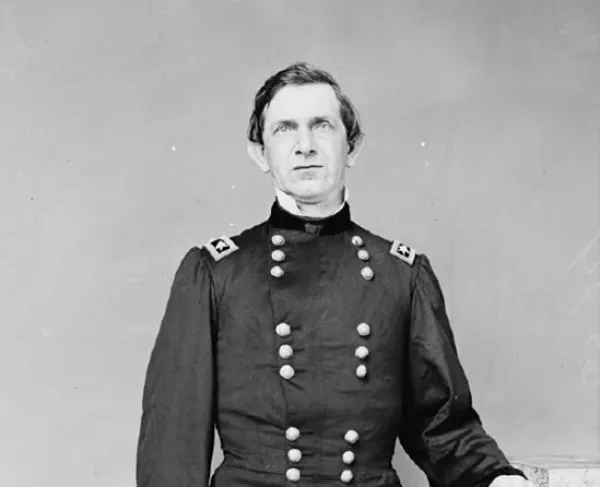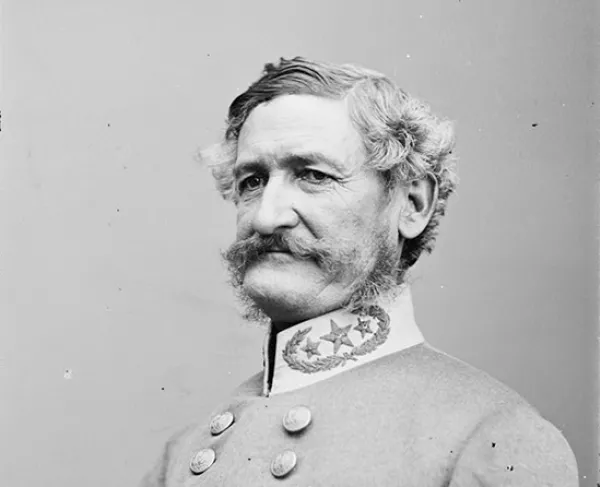Valverde, New Mexico | Feb 21, 1862
Fought in a dried riverbank of the Rio Grande with the backdrop of a large desert mesa, the Battle of Valverde paradoxically revealed the later actualization theme of the Union’s persevering strength over the Confederate troops in the west.
How It Ended
Confederate victory. Confederate General Henry Hopkins Sibley’s forces sent Union Colonel Edward R.S. Canby and his forces retreating to Fort Craig, but the Confederate troops were significantly ravaged and weakened after this battle.
In Context
General Sibley had been in the west for over a decade by the time of the battle. Before traveling westward, Sibley appealed that Jefferson Davis send Confederates to the American southwest. There, Sibley wanted to overtake Fort Union, as well as work toward gaining control over the Mexican territories of Sonora and Chihuahua. Sibley sought to inculcate negative feelings toward the Union within Colorado, New Mexico, Utah, Nevada, and California. Sibley’s proposition came during a time of Confederate military successes. Davis’s agreement with Sibley was bolstered by the allure of separating the Union from acquiring gold and other resources, and the global recognition and admiration that a land acquisition could bring. To this end, Davis ordered the newly promoted Brigadier General Sibley to call up an army to go to the New Mexico Territory. Sibley’s objective was to secure this land for the Confederates and remove the Union soldiers from their occupation here.
Previous smaller conflicts between the two forces had ascertained for Canby that Confederate troops in New Mexico presented a formidable challenge. Sibley and his troops trudged north as Union scouts reported this information back to Canby. Under Sibley’s authority was the Army of New Mexico, comprised of Baylor’s 2nd Texas Mounted Rifles, the 4th Texas Mounted Volunteers, the 5th Texas Mounted Volunteers, five companies from the 7th Texas Mounted Volunteers, and one battery from the 1st Texas Artillery. Canby’s 3,800-soldier force had 1,200 regulars, “eight companies from the 5th, 7th, and 10th U.S. Infantry, two provisional artillery batteries, companies from the 1st to 5th New Mexico Volunteers, companies from the 1st, 2nd and 3rd U.S. Calvary, Capt. Theodore Dodd’s independent company of Colorado volunteers, and about a thousand untrained New Mexico militiamen.” The night before the battle, Canby’s Union troops had come across and captured escaped Confederate mules, which meant that Sibley had to do away with many of the necessary Confederate resources; to achieve this, Union soldiers caused a stampede to scare away the Confederates’ cattle.
On February 21, General Sibley ordered that troops go ahead to the ford at Valverde to secure a position for the rest of the troops. In response, Canby quickly sent forces to meet the Confederates in battle. Sibley wanted to make Canby’s Union forces vulnerable to attack, but he failed; instead, Union troops led by Lieutenant Colonel Benjamin Roberts pushed the Confederates about one half of a mile away from the river, while Confederate lancers from Texas attacked the left side of the Union troops. This lancer attack was unsuccessful because the Colorado volunteer soldiers under the leadership of Dodd ferociously thwarted this advance.
After the failed Confederate lancer attack, a stalemate arose until around noon, during which the Confederate soldiers hid behind the riverbank. Canby ordered that troops cross the Rio Grande bank to attack the Confederates. Canby situated Captain McRae to his left and Lieutenant Robert Hall to his right. Seeing this, Confederate Colonel Thomas Green decided to attack head-on. When Major Thomas Duncan’s cavalry prepared for battle, Confederate Major Henry Wynkoop Raguet’s 200 soldiers on horseback approached rapidly with small firearms and cannons. General Kit Carson’s and Duncan’s soldiers abruptly halted the attacking Confederates. Riding the adrenaline of their miraculous response, these Union soldiers set out after the Confederate soldiers in retreat.
However, the Union flight toward the Confederates caused a schism in the Union line and Confederate Scurry took advantage of this by attacking the left flank of the Union troops and fought their way toward Union McRae’s cannons, who the Confederates beat in a direct soldier to soldier attack. McRae was killed and the Confederates overtook the Union cannon battery. Canby ordered that his men return to Fort Craig, and he asked for a truce.
276
229
In the Battle of Valverde, 160 Union soldiers were wounded, 34 went missing, 68 were killed, and 14 more died after from wounds sustained in the battle. The Confederate forces also took six of the Union guns. Canby’s troops remained strong in the region.
While Sibley and his soldiers had won the battle, both the troops and the supplies were severely weakened. In the Battle of Valverde, 150 soldiers were wounded in battle, 36 soldiers were killed in battle, and 43 soldiers were wounded but eventually passed away. Although the Confederates won the battle, they did not have the wherewithal to attack again, or to overtake Fort Craig from Canby.
Further Reading:
- Bloody Valverde: A Civil War Battle of the Rio Grande, February 21, 1862 By: John McLellan Taylor
- The New Mexico Campaign, 1862 By: Blue & Gray Magazine
All battles of the Sibley's New Mexico Campaign
Related Battles
3,800
2,510
276
229










